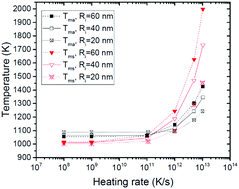Superheating and melting within aluminum core–oxide shell nanoparticles for a broad range of heating rates: multiphysics phase field modeling
Abstract
The external surface of metallic particles is usually covered by a thin and strong oxide shell, which significantly affects superheating and melting of particles. The effects of geometric parameters and heating rate on characteristic melting and superheating temperatures and melting behavior of aluminum nanoparticles covered by an oxide shell were studied numerically. For this purpose, the multiphysics model that includes the phase field model for surface melting, a dynamic equation of motion, a mechanical model for stress and strain simulations, interface and surface stresses, and the thermal conduction model including thermoelastic and thermo-phase transformation coupling as well as transformation dissipation rate was formulated. Several nontrivial phenomena were revealed. In comparison with a bare particle, the pressure generated in a core due to different thermal expansions of the core and shell and transformation volumetric expansion during melting, increases melting temperatures with the Clausius–Clapeyron factor of 60 K GPa−1. For the heating rates Q ≤ 109 K s−1, melting temperatures (surface and bulk start and finish melting temperatures, and maximum superheating temperature) are independent of Q. For Q ≥ 1012 K s−1, increasing Q generally increases melting temperatures and temperature for the shell fracture. Unconventional effects start for Q ≥ 1012 K s−1 due to kinetic superheating combined with heterogeneous melting and geometry. The obtained results are applied to shed light on the initial stage of the melt-dispersion-mechanism of the reaction of Al nanoparticles. Various physical phenomena that promote or suppress melting and affect melting temperatures and temperature of the shell fracture for different heating-rate ranges are summarized in the corresponding schemes.


 Please wait while we load your content...
Please wait while we load your content...